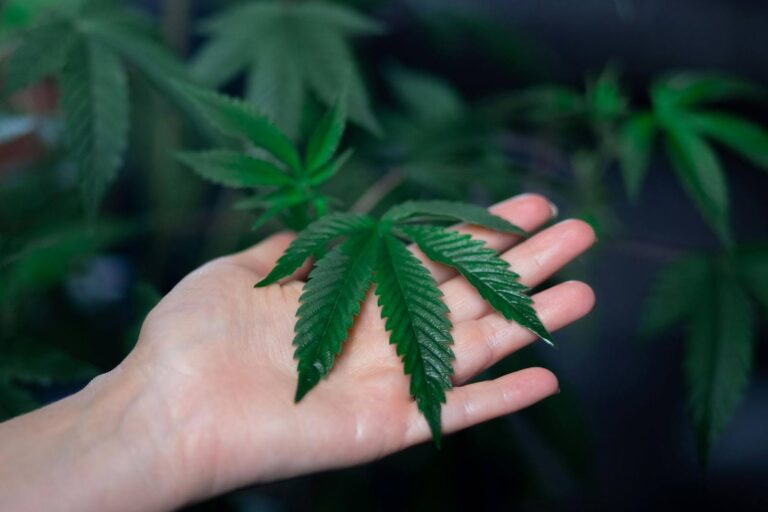Have you ever wondered why your cannabis plants are not thriving despite your best efforts? Maybe nutrients, water, and light are not the only factors. Microbes, including bacteria, play an essential role in cannabis cultivation, helping plants grow stronger, healthier, and more productive.
These microscopic organisms form the backbone of a thriving soil ecosystem, breaking down complex compounds, protecting plants from pathogens, and enhancing nutrient absorption.
Without them, even the best cultivation techniques might fall short. This article details the critical roles of microbes in cannabis cultivation, highlights the numerous benefits of beneficial bacteria such as LAB, discusses practical methods for introducing these microbes, and emphasizes why continuous monitoring of microbial impact is essential for achieving optimal plant growth and maximum yields.
The Role of Microbes in Cannabis Cultivation
Microbes form a symbiotic relationship with cannabis roots, enhancing plant health in multiple ways. These microbes improve nutrient uptake and produce enzymes that break down organic materials into usable forms. They create a protective biofilm around roots, shielding them from harmful organisms.
Additionally, microbes assist in hormone production that promotes root elongation and plant growth. This multifaceted support system provided by microbes strengthens cannabis plants from the ground up, ensuring they thrive even under challenging conditions. Here’s how microbes help in cultivating the cannabis plant:
- Nutrient Breakdown: They break down organic matter into simpler compounds that plants can absorb.
- Root Strengthening: Microbes help build stronger root systems, improving stability and nutrient uptake.
- Soil Enrichment: Microbes increase nutrient availability and soil structure by contributing to soil health.
- Improved Quality: Healthier roots and better nutrition lead to higher-quality cannabis yields.
- Disease Resistance: Beneficial microbes help suppress harmful pathogens, reducing the need for chemical pesticides.
- Stress Tolerance: They help plants cope with environmental stresses such as drought and nutrient deficiency.
- Nutrient Cycling: Microbes contribute to the cycling of essential nutrients like nitrogen and phosphorus, making them more accessible to plants.
Now, let us discuss the benefits of using essential bacteria in your cannabis plant.
Beneficial Bacteria for Cannabis Plants
Beneficial bacteria are essential for cannabis cultivation due to their multifaceted contributions. These microorganisms do much more than exist in the soil; they actively promote plant health by forming symbiotic relationships with roots, enhancing soil fertility through nutrient cycling, and even producing natural antibiotics that protect plants from harmful bacteria. Some of the benefits of bacteria for cannabis are:
1. Lactic Acid Bacteria (LAB)
LAB is a powerful group of microbes known for breaking down organic matter, suppressing harmful pathogens, and improving nutrient absorption. These bacteria produce lactic acid, which helps lower soil pH, making nutrients more bioavailable. Additionally, LAB can:
- Enhance decomposition of organic material
- Outcompete harmful bacteria and fungi
- Improve soil aeration and moisture retention
- Aid in disease resistance by producing antimicrobial compounds
- Enhance the availability of minerals like calcium and magnesium
2. Plant Growth-Promoting Rhizobacteria (PGPR)
PGPR colonize plant roots and promotes growth through various mechanisms. They help solubilize phosphorus, produce plant hormones like auxins, and suppress diseases by outcompeting harmful microbes. Some notable benefits include:
- Improved root development
- Increased resistance to stress (drought, salinity, etc.)
- Enhanced nutrient uptake
- Production of biofilm to protect roots from harmful organisms
- Induction of systemic resistance in plants against various pathogens
3. Nitrogen-Fixing Bacteria
Nitrogen is a key macronutrient for cannabis growth, and nitrogen-fixing bacteria convert atmospheric nitrogen into a plant-usable form. Some examples include:
- Rhizobium (forms symbiotic relationships with legumes, beneficial for companion planting)
- Azospirillum (associates with non-leguminous plants like cannabis to enhance nitrogen availability)
- Frankia (helps improve soil nitrogen content over time)
- Bradyrhizobium (a slow-growing nitrogen fixer that supports long-term soil fertility)
- Cyanobacteria (some species contribute to nitrogen fixation in aquatic or highly humid environments)
So, how does LAB act as a biostimulant and biofertilizer for your cannabis plant? Let us discuss this in detail.
LAB as a Biostimulant and Biofertilizer For Cannabis
Lactic acid bacteria (LAB) play a vital role in cannabis cultivation by serving as both a biostimulant and biofertilizer. LAB contributes to nutrient cycling, enhances plant immunity, and promotes vigorous growth through various metabolic processes. They produce organic acids that improve nutrient solubility in the soil, making essential minerals more available to cannabis plants. Here’s how LAB benefits the cannabis plant:
- Photosynthesis Efficiency: LAB enhances chlorophyll production, leading to improved photosynthesis and better energy conversion for growth. They also help plants maintain efficiency under stressful conditions.
- Soil Fertility: These bacteria break down organic matter, releasing essential nutrients that improve soil fertility and plant health. LAB contributes to organic composting processes, enriching soil naturally.
- Soil Structure: LAB helps bind soil particles, enhancing aeration, water retention, and overall soil structure, which is critical for cannabis root expansion.
- Nutrient Availability: By producing enzymes, LAB increases the availability of key nutrients like nitrogen, phosphorus, and potassium, essential for plant growth.
- Plant Growth Promotion: LAB produces plant growth hormones such as auxins, gibberellins, and cytokinins, which stimulate root, shoot, and overall plant development.
- Soil Microbiome Balance: LAB supports a balanced soil microbiome by outcompeting harmful bacteria and fungi and promoting beneficial microbial colonies that sustain soil health.
Now, let us understand how lactic acid bacteria help your cannabis plant fight pests and maintain soil health.
Now, let us discuss some of the methods you can use to introduce beneficial microbes to your cannabis plant.
Methods for Introducing Beneficial Microbes
Introducing beneficial microbes into cannabis cultivation is essential for improving plant health and yield. Here are the key methods you can use to introduce essential microbes to your cannabis yield:
- Soil Drenching: Introduce beneficial microbes by watering the soil with microbial solutions, ensuring they reach the root zone. This method is simple and effective for regular microbe applications.
- Seed Inoculation: Before planting, coat seeds with beneficial bacteria to enhance germination and initial root colonization. This protects seeds and boosts early growth.
- Foliar Sprays: Apply microbial solutions directly to cannabis leaves, promoting nutrient absorption, protecting against foliar diseases, and enhancing photosynthesis.
- Compost and Manure Integration: Add compost or well-decomposed manure rich in beneficial microbes to improve soil microbial diversity, enhance nutrient content, and build long-term soil health.
- Root Zone Inoculation: During transplanting, directly inoculate the root zone with microbial powders or liquids for immediate root-microbe interaction and faster establishment.
- Cover Cropping: Plant cover crops that support microbial life, fix nitrogen, improve soil structure, and increase beneficial bacteria populations in the soil, especially in off-seasons or between cannabis growth cycles.
Let us now understand how to monitor your cannabis plant properly to analyse the proper deliverance of microbes in your cannabis.
Monitoring and Utilizing Microbial Impact On Cannabis
Monitoring microbial impact is crucial in cannabis cultivation. This involves regular assessments and detailed analyses, evaluating soil health parameters, tracking microbial interactions with plant roots, and recording seasonal variations in microbial populations.
You can gain deep insights using advanced tools like DNA sequencing for microbial identification and digital dashboards for real-time tracking. Let us discover the expanded methods, tools, and strategies to ensure thorough microbial monitoring and utilization. This includes:
- Regular Soil Tests: Assess microbial diversity, population density, and nutrient levels. They also include periodic lab tests for microbial DNA analysis and enzymatic activity.
- Plant Growth Observation: Monitor root health, leaf color, plant size, and yield while tracking stress responses and disease resistance.
- Nutrient Tracking: Measure nutrient availability in soil and plant tissues, including micronutrient levels and microbial nutrient cycling efficiency.
- Tools and Techniques: Use microbial assays, pH meters, moisture sensors, plant health monitoring systems, and digital platforms for data analysis and visualization to make informed decisions. PlanaCan eliminates the guesswork in monitoring soil conditions and captures data on every harvest, linking decisions to their real impact. Consolidating insights helps refine methods for higher yields and bigger profits.
So, how do you ensure long-term microbial management for the growth of your cannabis plant? Here’s how to do it.
Long-Term Microbial Management for Sustainable Cultivation
Maintaining microbial health over multiple growing seasons is key to sustaining soil fertility and ensuring consistent, high-quality cannabis yields. Here are a few strategies you can use for long-term microbial management:
- Crop Rotation: Rotating crops helps balance nutrient needs and prevents any one microbe from dominating, promoting diversity and long-term soil health.
- Organic Amendments: Add compost, manure, or cover crops regularly to feed beneficial microbes, encourage growth, and maintain a thriving soil ecosystem.
- Avoiding Overuse of Sterilizing Agents: Minimize using chemical pesticides or fungicides, as these can harm beneficial microbes. Opt for organic solutions when possible to protect your soil’s microbial balance.
- Monitoring Soil pH and Moisture: Regularly check and adjust soil pH (ideally 6.0-7.0) and moisture levels to support healthy microbial activity and efficient nutrient cycling. PlanaCan eliminates the guesswork in monitoring soil conditions and tracks data from every harvest, linking decisions to their real impact. PlanaCan helps refine methods for higher yields and greater profits by consolidating insights.
- Creating a Balanced Microbial Ecosystem: Foster a variety of microbes (bacteria, fungi, etc.) to create a resilient soil microbiome capable of handling various stresses and challenges over time.
- Incorporating Mycorrhizal Fungi: Add mycorrhizal fungi to enhance nutrient uptake, particularly phosphorus, and improve soil structure, benefiting long-term plant health.
- Avoiding Soil Compaction: Avoid foot traffic on beds and use tools that preserve soil structure to prevent soil compaction. This will allow microbes to thrive in healthy soil.
- Ensuring Adequate Soil Aeration: Support aerobic microbes by improving soil aeration through mulching or tilling, which enhances water flow and nutrient availability.
- Managing Organic Waste Properly: Compost organic waste correctly to avoid introducing harmful pathogens and pests, enrich soil fertility, and boost microbial life.
- Using Microbial Inoculants During Transitions: Replenish microbial populations during crop transitions with inoculants to ensure healthy soil for the next planting cycle.
- Promoting Microbial Resilience to Environmental Stresses: Biochar or other soil amendments can stabilize microbes during extreme weather, ensuring they thrive under stress.
- Educating Yourself on New Microbial Technologies: Stay updated on the latest microbial products and technologies to enhance soil health and cultivation success further.
Conclusion
Integrating beneficial bacteria into cannabis cultivation leads to healthier plants, stronger roots, improved nutrient uptake, and higher yields. Beneficial microbes enhance plant resilience to stress, reduce disease risks, and contribute to sustainable growing practices. By nurturing a thriving microbial ecosystem, you ensure that cannabis plants are strong, productive, and resilient.
PlanaCan‘s advanced tools and smooth technology help you maximize your cultivation benefits. It streamlines your processes by allowing you to define, automate, and manage tasks using customizable templates, ensuring even the most complex steps are handled efficiently. From planting to harvest, everything is meticulously organized for specific strains or cycles, reducing errors and saving you time.
It also provides a clear timeline for planning, tracking, and adjusting tasks, helping you stay ahead of schedule and adapt to changes. You can plan long-term while managing daily activities, giving you full control over your operation. PlanaCan centralizes all key information—from task assignments to crop progress—making it easier to stay on top of things, avoid oversights, and boost yields. With PlanaCan, you can focus more on cultivation and less on administrative tasks.
Schedule a free call today to see how PlanaCan can transform your cannabis cultivation experience and help you achieve higher yields with less hassle.




